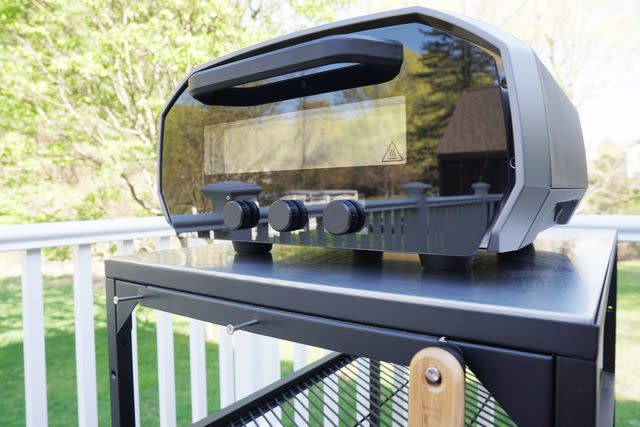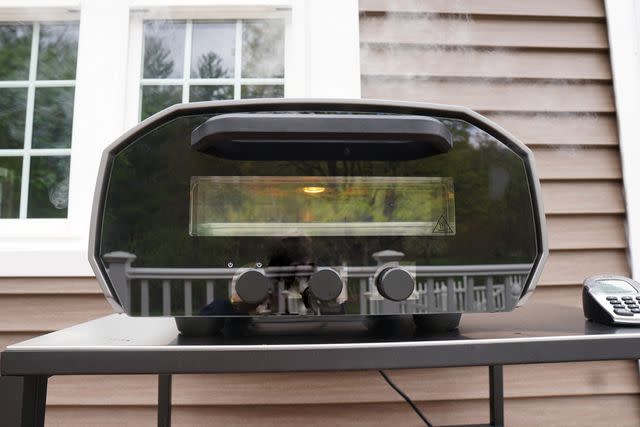We Made a Dozen Pies in Ooni’s First-Ever Electric Pizza Oven—It Was Awesome
Dotdash Meredith and Yahoo Inc. may earn commission or revenue on some items through the links below.
The Ooni Volt works indoors and outdoors, and it’s exceptionally easy to use.

Serious Eats / Riddley Gemperlein-Schirm
The Ooni Volt made phenomenal pies (both inside and outside). It was exceptionally easy to use, too, and we think even beginners would enjoy slinging pies with it.
Ooni has oodles of pizza ovens. So many, in fact, we reviewed and created a guide to them.
However, all of those models are gas-, wood-, or pellet-powered. And absolutely none of them should be used indoors, limiting these ovens to those who have the outdoor space and, for much of the country (ahem, like where I live in New England), shortening pizza oven season to the handful of months when it’s pleasant to cook outside.
That is until the Ooni Volt came out this March. It’s the company’s first indoor-outdoor countertop pizza oven—and it’s electric, capable of reaching 850°F in just 20 minutes, according to the company, and cooking Neapolitan-style pizza in 90 seconds. For context, you need a deck temperature of 700°F, at a minimum, for Neapolitan pies. The only other indoor pizza oven we reviewed, the Breville Pizzaiolo maxes out at 750°F, which makes the Volt’s temperature range impressive.
To find out if the Ooni Volt could produce the kind of puffy, pillowy, leopard-spotted Neapolitan pies it claimed it could, we made a dozen pizzas with it.
The Tests

Serious Eats / Riddley Gemperlein-Schirm
Temperature Test: We set the Volt to its max temp (850°F) and took the temp in the center of its stone every five minutes for 20 minutes using an infrared thermometer, to see how quickly the oven heated up and if it was hitting its stated temperature.
Outdoor Pizza Test: We made broccoli rabe and anchovy pizza outdoors, using an infrared thermometer to take the temp of the stone before and after loading each pie. We timed how long it took for each pizza to cook and gave the oven a more substantial recovery time between each pie (about seven minutes).
Indoor Pizza Test: We made burst tomato, shallot, and herb pizza indoors. This time, we kept the recovery time between each pie shorter, waiting three minutes in between pizzas. We timed how long it took each pie to cook.
Usability Tests: Throughout testing, we evaluated how intuitive the Volt’s controls were and how easy it was to load, turn, and retrieve pizzas. We looked at other factors, too, like if it released a lot of smoke when cooking inside and if it was easy to move.
Cleanup Tests: Twice during testing we cleaned the oven and stone according to the manufacturer’s instructions, evaluating how easy it was to do so.
What We Learned
How the Ooni Volt Worked

Serious Eats / Riddley Gemperlein-Schirm
The outdoor Ooni I use, the Koda 16, has an L-shaped flame in the back corner that wraps around its sides and partially up its ceiling. The Volt, as appropriate for something used indoors, is flame-free. Instead, it has two heating elements on the top and bottom of the oven, the latter under its baking stone. Depending on the temperature you select, the oven automatically adjusts the output of both heating elements (though you can manually override this). Different styles of pies require various temperatures and benefit from hotter upper or lower elements. If this sounds even mildly confusing, don’t worry: the oven includes a guide as to what temperature to use for each pizza type. For example, Neapolitan should be cooked at 850°F and the oven will favor the top heating element. New York pies, on the other hand, should be cooked at 650°F, and the heat will be much more balanced between the top and bottom elements.
Because the Volt is electric and adjusts its heating elements automatically, this makes the oven incredibly easy to use. We mean that: it’s so well-designed there’s virtually zero guesswork—no tinkering to get the flame just right, no worrying about when you’ll need to add more fuel.
The Volt Made Really Fantastic Pizza

Serious Eats / RIddley Gemperlein-Schirm
Impressively, the Volt hit its advertised temperatures—clocking in at 850°F in 20 minutes, with temperatures that surpassed this the longer it was on. Consistently, the pizzas we cooked came out with crispy bases, pillowy crusts, and leopard-spotted bottoms. Pies cooked in 90 seconds to two minutes on average, with a couple of pies taking just two minutes and 20 seconds. The oven didn’t need much recovery time either. The Volt’s temperature dial flashed to let you know when the temp dropped below its designated setting. Once that turned off (in just a couple of minutes), the oven was ready to go again.
The Volt Was Thoughtfully Designed, Especially for Indoor Use

Serious Eats / Riddley Gemperlein-Schirm
With a touchscreen and control dials, the Volt feels like a beautifully designed countertop appliance—because it is one. We liked its non-slip feet, carbon steel shell (that, amazingly, never got super hot), glass door, interior light, and built-in side handles for lifting and moving (though, of course, it’s still a bulky, 39-pound oven, so it will never be that easy to transport). It was also incredibly quiet. In fact, my toaster oven is louder than the Volt.

Serious Eats / Riddley Gemperlein-Schirm
One thing to note is that excess flour in the oven can (and will) cause it to smoke. This isn’t a big deal outdoors but is something to be mindful of inside. However, I made sure to apply liberal dustings of flour to my dough and peels, to see how much smoke the Volt would put out indoors. After about 40 minutes of slinging pies, the smoke didn’t set off my (sensitive!) fire alarm and was akin to letting a cast iron skillet go for too long on the stovetop. When I used a more judicious amount of flour, though, the Volt didn't smoke at all.
Lastly, a few usability quibbles: I could’ve done with a slightly longer power cord and, maybe, some sort of cord storage solution. After using the oven for a prolonged time, the touchscreen (where the control button is) got a little hot, too.
The Verdict
Ooni Volt 12 Electric Pizza Oven

Pros
The Volt is a phenomenal, powerful electric pizza oven. The pizzas we made in it impressed us and we loved its usability features, like its intuitive controls and adjustable heating elements. If you lack outdoor space, are looking for an indoor-outdoor pizza oven, or are searching for a pizza oven that’ll require very little tinkering to nail beautiful pies, we highly recommend the Volt.
Cons
The Volt is quite large and, likely, will have to be stored elsewhere when not in use. At nearly $1,000, it’s also very expensive—more so than any of Ooni’s other ovens.
Key Specs
Weight: 39.2 pounds
Dimensions: 24.2 x 20.8 x 10.9 inches
Temperature range: 150 to 850°F
Warranty: 1-year (standard); 2 years (if registered online)
Compatible with: Cover for Ooni Volt 12
Price at time of publish: $999
FAQs
How do you clean the Ooni Volt?
To clean the Volt, the manufacturer recommends waiting until the oven is completely cool. Then, you can remove the stone to discard any loose or large debris (it should not be washed). The glass door can be cleaned with a dry paper towel or with a paper towel and warm, soapy water for tougher messes (dry thoroughly afterward). The exterior of the oven can just be wiped down with a clean, damp cloth and then dried. “Your Ooni Volt 12 should not require any interior cleaning. Any food residue should burn off when in use,” the company notes.
What’s the best Ooni pizza oven?
The best Ooni oven for you depends on a few factors: which mode of power you want (gas, wood, pellet, or electric), what size oven you want, and how much you want to spend. You can find our detailed comparison of all of the Ooni ovens here.
Editor’s note: We received a press sample of the Ooni Volt, but all of our opinions are our own.
Read More:Which Ooni Pizza Oven Should You Buy? We Compared Them All

